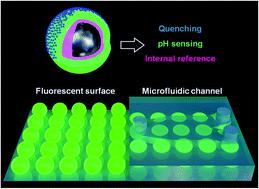Our official English website, www.x-mol.net, welcomes your
feedback! (Note: you will need to create a separate account there.)
Thinking outside the shell: novel sensors designed from plasmon-enhanced fluorescent concentric nanoparticles.
Analyst ( IF 3.6 ) Pub Date : 2020-08-20 , DOI: 10.1039/d0an01092h Nicolas Fontaine 1 , Audrey Picard-Lafond , Jérémie Asselin , Denis Boudreau
Analyst ( IF 3.6 ) Pub Date : 2020-08-20 , DOI: 10.1039/d0an01092h Nicolas Fontaine 1 , Audrey Picard-Lafond , Jérémie Asselin , Denis Boudreau
Affiliation

|
The alteration of photophysical properties of fluorophores in the vicinity of a metallic nanostructure, a phenomenon termed plasmon- or metal-enhanced fluorescence (MEF), has been investigated extensively and used in a variety of proof-of-concept demonstrations over the years. A particularly active area of development in this regard has been the design of nanostructures where fluorophore and metallic core are held in a stable geometry that imparts improved luminosity and photostability to a plethora of organic fluorophores. This minireview presents an overview of MEF-based concentric core–shell sensors developed in the past few years. These architectures expand the range of applications of nanoparticles (NPs) beyond the uses possible with fluorescent molecules. Design aspects that are being described include the influence of the nanocomposite structure on MEF, notably the dependence of fluorescence intensity and lifetime on the distance to the plasmonic core. The chemical composition of nanocomposites as a design feature is also discussed, taking as an example the use of non-noble plasmonic metals such as indium as core materials to enhance multiple fluorophores throughout the UV-Vis range and tune the sensitivity of halide-sensing fluorophores operating on the principle of collisional quenching. Finally, the paper describes how various solid substrates can be functionalized with MEF-based nanosensors to bestow them with intense and photostable pH-sensitive properties for use in fields such as medical therapy and diagnostics, dentistry, biochemistry and microfluidics.
中文翻译:

壳外思考:由等离激元增强的荧光同心纳米粒子设计的新型传感器。
多年来,人们广泛研究了金属纳米结构附近的荧光团的光物理性质变化,这种现象被称为等离激元或金属增强的荧光(MEF),并已用于各种概念验证演示中。在这方面,特别活跃的发展领域是纳米结构的设计,其中荧光团和金属核保持稳定的几何形状,从而为多种有机荧光团带来了改善的发光度和光稳定性。这份小型回顾概述了过去几年中开发的基于MEF的同心核壳传感器。这些架构扩展了纳米粒子(NPs)的应用范围,超出了荧光分子可能的用途。所描述的设计方面包括纳米复合材料结构对MEF的影响,尤其是荧光强度和寿命对等离激元核心距离的依赖性。还以纳米复合材料的化学成分为设计特征进行了讨论,以使用非贵金属等离子金属(例如铟)为核心材料来增强整个UV-Vis范围内的多种荧光团并调整卤化物传感荧光团的灵敏度为例。根据碰撞淬火原理进行操作。最后,本文描述了如何使用基于MEF的纳米传感器对各种固体底物进行功能化,使其具有强烈且耐光的pH敏感特性,可用于医学治疗和诊断,牙科,生物化学和微流控等领域。值得注意的是,荧光强度和寿命取决于与等离子体中心的距离。还以纳米复合材料的化学成分为设计特征进行了讨论,以使用非贵金属等离子金属(例如铟)为核心材料来增强整个UV-Vis范围内的多种荧光团并调整卤化物感测荧光团的灵敏度为例。根据碰撞淬火原理进行操作。最后,本文描述了如何使用基于MEF的纳米传感器对各种固体底物进行功能化,使其具有强烈且耐光的pH敏感特性,可用于医学治疗和诊断,牙科,生物化学和微流控等领域。值得注意的是,荧光强度和寿命取决于与等离子体中心的距离。还以纳米复合材料的化学成分为设计特征进行了讨论,以使用非贵金属等离子金属(例如铟)为核心材料来增强整个UV-Vis范围内的多种荧光团并调整卤化物感测荧光团的灵敏度为例。根据碰撞淬火原理进行操作。最后,本文描述了如何使用基于MEF的纳米传感器对各种固体底物进行功能化,使其具有强烈且耐光的pH敏感特性,可用于医学治疗和诊断,牙科,生物化学和微流控等领域。还以纳米复合材料的化学成分为设计特征进行了讨论,以使用非贵金属等离子金属(例如铟)为核心材料来增强整个UV-Vis范围内的多种荧光团并调整卤化物传感荧光团的灵敏度为例。根据碰撞淬火原理进行操作。最后,本文描述了如何使用基于MEF的纳米传感器对各种固体底物进行功能化,使其具有强烈且耐光的pH敏感特性,可用于医学治疗和诊断,牙科,生物化学和微流控等领域。还以纳米复合材料的化学成分为设计特征进行了讨论,以使用非贵金属等离子金属(例如铟)为核心材料来增强整个UV-Vis范围内的多种荧光团并调整卤化物感测荧光团的灵敏度为例。根据碰撞淬火原理进行操作。最后,本文描述了如何使用基于MEF的纳米传感器对各种固体底物进行功能化,使其具有强烈且耐光的pH敏感特性,可用于医学治疗和诊断,牙科,生物化学和微流控等领域。以使用非贵金属等离子金属(如铟)为核心材料为例,以增强整个UV-Vis范围内的多种荧光团并调整基于碰撞猝灭原理的卤化物传感荧光团的灵敏度。最后,本文描述了如何使用基于MEF的纳米传感器对各种固体底物进行功能化,使其具有强烈且耐光的pH敏感特性,可用于医学治疗和诊断,牙科,生物化学和微流控等领域。以使用非贵金属等离子金属(如铟)为核心材料为例,以增强整个UV-Vis范围内的多种荧光团并调整基于碰撞猝灭原理的卤化物传感荧光团的灵敏度。最后,本文描述了如何使用基于MEF的纳米传感器对各种固体底物进行功能化,使其具有强烈且耐光的pH敏感特性,可用于医学治疗和诊断,牙科,生物化学和微流控等领域。
更新日期:2020-09-14
中文翻译:

壳外思考:由等离激元增强的荧光同心纳米粒子设计的新型传感器。
多年来,人们广泛研究了金属纳米结构附近的荧光团的光物理性质变化,这种现象被称为等离激元或金属增强的荧光(MEF),并已用于各种概念验证演示中。在这方面,特别活跃的发展领域是纳米结构的设计,其中荧光团和金属核保持稳定的几何形状,从而为多种有机荧光团带来了改善的发光度和光稳定性。这份小型回顾概述了过去几年中开发的基于MEF的同心核壳传感器。这些架构扩展了纳米粒子(NPs)的应用范围,超出了荧光分子可能的用途。所描述的设计方面包括纳米复合材料结构对MEF的影响,尤其是荧光强度和寿命对等离激元核心距离的依赖性。还以纳米复合材料的化学成分为设计特征进行了讨论,以使用非贵金属等离子金属(例如铟)为核心材料来增强整个UV-Vis范围内的多种荧光团并调整卤化物传感荧光团的灵敏度为例。根据碰撞淬火原理进行操作。最后,本文描述了如何使用基于MEF的纳米传感器对各种固体底物进行功能化,使其具有强烈且耐光的pH敏感特性,可用于医学治疗和诊断,牙科,生物化学和微流控等领域。值得注意的是,荧光强度和寿命取决于与等离子体中心的距离。还以纳米复合材料的化学成分为设计特征进行了讨论,以使用非贵金属等离子金属(例如铟)为核心材料来增强整个UV-Vis范围内的多种荧光团并调整卤化物感测荧光团的灵敏度为例。根据碰撞淬火原理进行操作。最后,本文描述了如何使用基于MEF的纳米传感器对各种固体底物进行功能化,使其具有强烈且耐光的pH敏感特性,可用于医学治疗和诊断,牙科,生物化学和微流控等领域。值得注意的是,荧光强度和寿命取决于与等离子体中心的距离。还以纳米复合材料的化学成分为设计特征进行了讨论,以使用非贵金属等离子金属(例如铟)为核心材料来增强整个UV-Vis范围内的多种荧光团并调整卤化物感测荧光团的灵敏度为例。根据碰撞淬火原理进行操作。最后,本文描述了如何使用基于MEF的纳米传感器对各种固体底物进行功能化,使其具有强烈且耐光的pH敏感特性,可用于医学治疗和诊断,牙科,生物化学和微流控等领域。还以纳米复合材料的化学成分为设计特征进行了讨论,以使用非贵金属等离子金属(例如铟)为核心材料来增强整个UV-Vis范围内的多种荧光团并调整卤化物传感荧光团的灵敏度为例。根据碰撞淬火原理进行操作。最后,本文描述了如何使用基于MEF的纳米传感器对各种固体底物进行功能化,使其具有强烈且耐光的pH敏感特性,可用于医学治疗和诊断,牙科,生物化学和微流控等领域。还以纳米复合材料的化学成分为设计特征进行了讨论,以使用非贵金属等离子金属(例如铟)为核心材料来增强整个UV-Vis范围内的多种荧光团并调整卤化物感测荧光团的灵敏度为例。根据碰撞淬火原理进行操作。最后,本文描述了如何使用基于MEF的纳米传感器对各种固体底物进行功能化,使其具有强烈且耐光的pH敏感特性,可用于医学治疗和诊断,牙科,生物化学和微流控等领域。以使用非贵金属等离子金属(如铟)为核心材料为例,以增强整个UV-Vis范围内的多种荧光团并调整基于碰撞猝灭原理的卤化物传感荧光团的灵敏度。最后,本文描述了如何使用基于MEF的纳米传感器对各种固体底物进行功能化,使其具有强烈且耐光的pH敏感特性,可用于医学治疗和诊断,牙科,生物化学和微流控等领域。以使用非贵金属等离子金属(如铟)为核心材料为例,以增强整个UV-Vis范围内的多种荧光团并调整基于碰撞猝灭原理的卤化物传感荧光团的灵敏度。最后,本文描述了如何使用基于MEF的纳米传感器对各种固体底物进行功能化,使其具有强烈且耐光的pH敏感特性,可用于医学治疗和诊断,牙科,生物化学和微流控等领域。









































 京公网安备 11010802027423号
京公网安备 11010802027423号